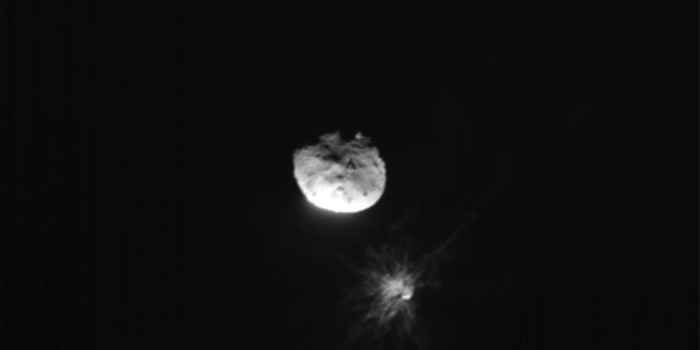
DART probe actually deflects asteroid from its orbit
It was only a test - but a successful one. Data shows that the US space agency has indeed succeeded in deliberately altering the course of an asteroid.
It has been just over two weeks since the US space agency NASA let the spacecraft "DART" collide with the asteroid Dimorphos. Now it is clear: the mission was successful. The force of the impact shortened the orbit of Dimorphos around its larger companion Didymos by a good 32 minutes, NASA announced. Whereas Dimorphos previously took eleven hours and 55 minutes to orbit Didymos, it now takes eleven hours and 23 minutes. The Double Asteroid Redirection Test (DART) has thus exceeded the minimum target of 73 seconds by more than 25 times.
"This mission demonstrates that the Dimorphos orbiter is capable of completing its orbit in the time required.
"This mission shows that NASA is trying to be ready for whatever the universe throws at us," said NASA chief Bill Nelson in a press conference. And: "We all have a responsibility to protect our home planet. After all, it's the only one we have. NASA has proven that we are serious about being the defenders of our planet." This is the first time mankind has intentionally altered the motion of a celestial body. At a speed of almost 22 000 kilometres per hour, the DART probe, the size of a drinks machine, had collided with the asteroid Dimorphos, which is about the size of a football stadium, at the end of September. Shortly after the collision, images from the Webb and Hubble space telescopes and numerous Earth-based observatories showed the impressive tail of debris and loose rubble created by the force of the impact. Because of the gravitational forces acting between Dimorphos and Didymos, the mission also has an effect on the direction of motion of the asteroid pair as a whole. Which one will now be investigated further in the coming weeks and months.
"This initial result is an important step in fully understanding the impact of DART's impact on the target asteroid," said Lori Glaze, director of NASA's Planetary Science Division. "With new data arriving daily, astronomers can better assess if and how a mission like DART could be used in the future to protect Earth from a collision with an asteroid if we ever detect one heading our way."
NASA stresses that neither Dimorphos nor Didymos posed a threat to Earth before or after the controlled collision. Rather, it was a test run for defence against an asteroid on a collision course with Earth. For our planet is a cosmic target: Every second, rocks from space pelt the Earth. The vast majority are only fractions of a millimetre in size and burn up completely when they enter the Earth's atmosphere. But there are about 210 known craters on Earth that testify to the impact of a larger celestial body.
In about four years, both Dimorphos and Didymos will be measured in detail as part of the European Space Agency's Hera project. The main focus will be on the crater left by the collision with DART. In addition, the mass and composition of Dimorphos will be determined more precisely.
Spectrum of Science
We are partners of Spektrum der Wissenschaft and want to make sound information more accessible to you. Follow Spektrum der Wissenschaft if you like the articles .
Originalartikel auf Spektrum.deTitelbild: ASI/NASA
Experts from science and research report on the latest findings in their fields – competent, authentic and comprehensible.